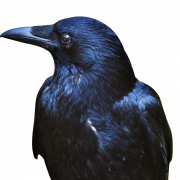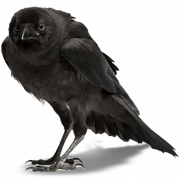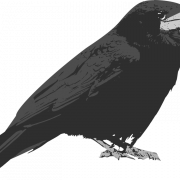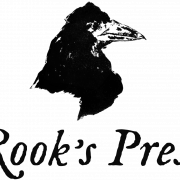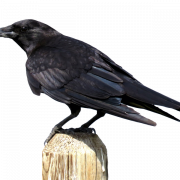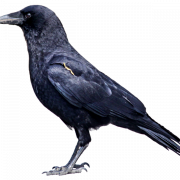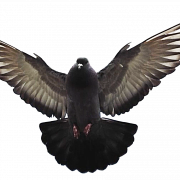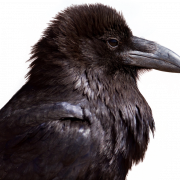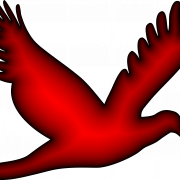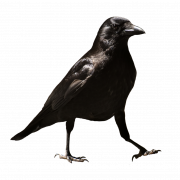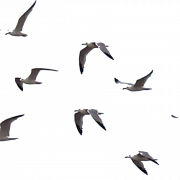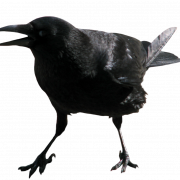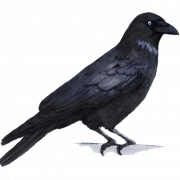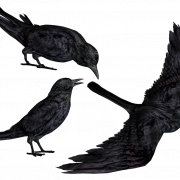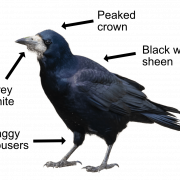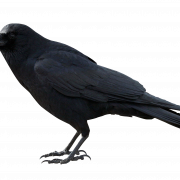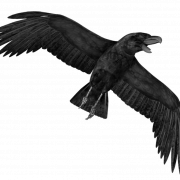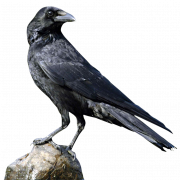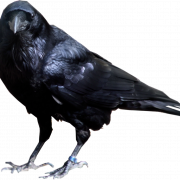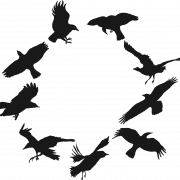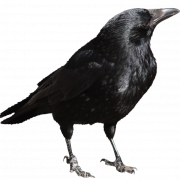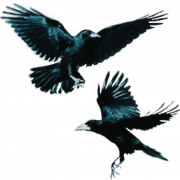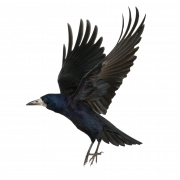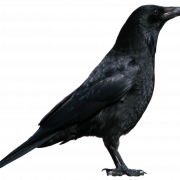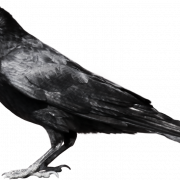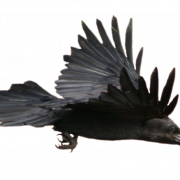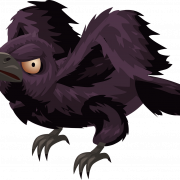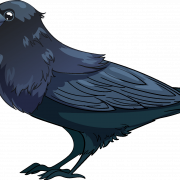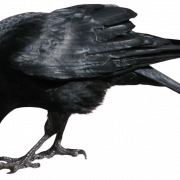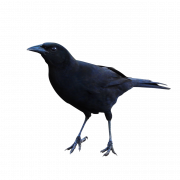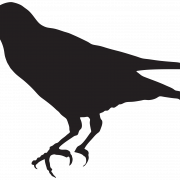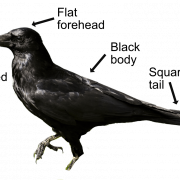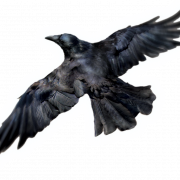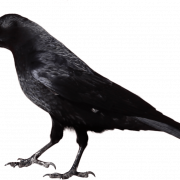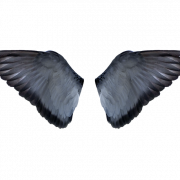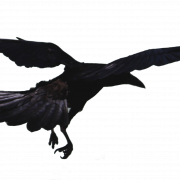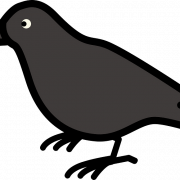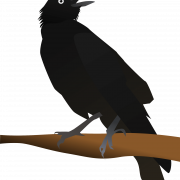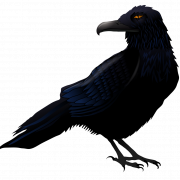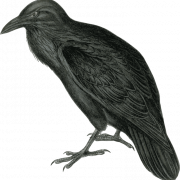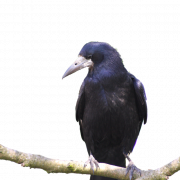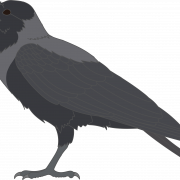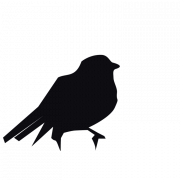Download top and best high-quality free Rook Bird PNG Transparent Images backgrounds available in various sizes. To view the full PNG size resolution click on any of the below image thumbnail.
License Info: Creative Commons 4.0 BY-NC
The rook (Corvus frugilegus) belongs to the Corvidae family of birds in the passerine order. Its range extends from Scandinavia and western Europe to eastern Siberia in the Palearctic. It is a big, gregarious black-feathered bird with a pale featherless patch on the face that distinguishes it from related species. Rooks build their nests at the tops of large trees, frequently near farms or villages, and rookeries are collections of nests.
Rooks are primarily resident birds. However, the northernmost populations may migrate south during the winter to avoid the worst weather. In the winter, the birds congregate in flocks, frequently with other Corvus species or jackdaws. In the spring, they return to their rookeries and begin reproducing. They graze on arable land and pasture, probing the ground with their powerful bills and mostly eating grubs and soil-based invertebrates, but occasionally grains and other plant material. Farmers have accused the birds of destroying their crops in the past and have attempted to drive them away or kill them. They are clever birds, like other corvids, with complex behavioral characteristics and the capacity to solve basic problems.
Carl Linnaeus, a Swedish scientist, gave the rook its binomial name in his Systema Naturae in 1758. Corvus means “raven” in Latin, while frugilegus means “fruit-gathering” in English. It comes from the Latin words frux or frugis, which means “fruit,” and legere, which means “to pick.” The English-language common name rook is derived from the harsh call of the bird. The western rook (C. f. frugilegus) may be found from western Europe to southern Russia and extreme northwestern China, whereas the eastern rook (C. f. pastinator) can be found from middle Siberia to northern Mongolia and eastwards through Asia. Building, parliament, uproar, and narrative are all collective words for rooks. The name rookery was used to describe their colonial nesting behavior.
The rook is a big bird with an adult weight of 280 to 340 g (9.9 to 12.0 oz), a length of 44 to 46 cm (17 to 18 in), and a wingspan of 81 to 99 cm (32 to 39 in). In strong sunshine, its black feathers take on a blue or bluish-purple gloss. The head, neck, and shoulders have especially thick and silky feathers.
The bill is grey-black, the legs and feet are black, and the iris is dark brown. The rook may be recognized from other members of the crow family by a bare patch of pale skin in front of the eye and around the base of the beak in adults. This bare area provides the impression that the bill is longer and the head is more domed than it really is.
The rook’s leg feathering is also shaggier and laxer than that of the carrion crow, the only other member of the species with which it is likely to be mistaken. Furthermore, a rook’s wings are proportionately larger and thinner than those of a carrion crow when observed in flight. Six years is the average lifetime.
Except for the hind neck, back, and underparts, which are brownish-black, the juvenile plumage is black with a little greenish sheen. Because it lacks the bare patch at the base of the bill, the juvenile looks like a young crow, but it has a smaller beak and loses its facial feathers after approximately six months.
Download Rook Bird PNG images transparent gallery.
- Rook Bird PNG Pic
Resolution: 1204 × 1065
Size: 1453 KB
Image Format: .png
Download
- Rook Bird PNG Download Image
Resolution: 732 × 700
Size: 313 KB
Image Format: .png
Download
- Rook Bird Silhouette PNG Image
Resolution: 1280 × 876
Size: 39 KB
Image Format: .png
Download
- Rook Bird PNG High Quality Image
Resolution: 1013 × 750
Size: 80 KB
Image Format: .png
Download
- Rook Bird PNG Images
Resolution: 1280 × 665
Size: 149 KB
Image Format: .png
Download
- Rook Bird Silhouette Transparent
Resolution: 1275 × 750
Size: 26 KB
Image Format: .png
Download
- Rook Bird Silhouette PNG Clipart
Resolution: 981 × 750
Size: 21 KB
Image Format: .png
Download
- Rook Bird PNG Image File
Resolution: 1280 × 987
Size: 261 KB
Image Format: .png
Download
- Rook Bird Transparent
Resolution: 769 × 600
Size: 381 KB
Image Format: .png
Download
- Sitting Rook Bird
Resolution: 684 × 600
Size: 347 KB
Image Format: .png
Download
- Flying Rook Bird
Resolution: 1181 × 873
Size: 629 KB
Image Format: .png
Download
- Sitting Rook Bird PNG Images
Resolution: 1024 × 837
Size: 1318 KB
Image Format: .png
Download
- Flying Rook Bird PNG Pic
Resolution: 2322 × 1964
Size: 668 KB
Image Format: .png
Download
- Sitting Rook Bird PNG Image File
Resolution: 1140 × 1132
Size: 504 KB
Image Format: .png
Download
- Flying Rook Bird PNG Download Image
Resolution: 3052 × 1580
Size: 587 KB
Image Format: .png
Download
- Rook Bird PNG Photo
Resolution: 947 × 844
Size: 442 KB
Image Format: .png
Download
- Rook Bird PNG Image HD
Resolution: 1330 × 1144
Size: 643 KB
Image Format: .png
Download
- Flying Rook Bird PNG
Resolution: 1024 × 773
Size: 527 KB
Image Format: .png
Download
- Sitting Rook Bird PNG
Resolution: 1042 × 823
Size: 131 KB
Image Format: .png
Download
- Sitting Rook Bird PNG Image
Resolution: 2192 × 1668
Size: 1214 KB
Image Format: .png
Download
- Flying Rook Bird PNG Image
Resolution: 1000 × 786
Size: 278 KB
Image Format: .png
Download
- Sitting Rook Bird Transparent
Resolution: 1024 × 968
Size: 545 KB
Image Format: .png
Download
- Sitting Rook Bird PNG Clipart
Resolution: 1630 × 1468
Size: 1754 KB
Image Format: .png
Download
- Flying Rook Bird Transparent
Resolution: 1387 × 1279
Size: 35 KB
Image Format: .png
Download
- Sitting Rook Bird PNG Free Download
Resolution: 840 × 785
Size: 384 KB
Image Format: .png
Download
- Flying Rook Bird PNG Clipart
Resolution: 856 × 843
Size: 492 KB
Image Format: .png
Download
- Flying Rook Bird PNG Free Download
Resolution: 890 × 897
Size: 425 KB
Image Format: .png
Download
- Flying Rook Bird PNG Picture
Resolution: 1000 × 1000
Size: 58 KB
Image Format: .png
Download
- Sitting Rook Bird PNG Free Image
Resolution: 1024 × 888
Size: 878 KB
Image Format: .png
Download
- Sitting Rook Bird PNG Picture
Resolution: 1106 × 715
Size: 491 KB
Image Format: .png
Download
- Flying Rook Bird PNG Free Image
Resolution: 800 × 544
Size: 268 KB
Image Format: .png
Download
- Sitting Rook Bird PNG File
Resolution: 1920 × 1453
Size: 144 KB
Image Format: .png
Download
- Sitting Rook Bird PNG HD Image
Resolution: 1920 × 1254
Size: 141 KB
Image Format: .png
Download
- Rook Bird
Resolution: 1144 × 698
Size: 234 KB
Image Format: .png
Download
- Rook Bird PNG
Resolution: 1280 × 1280
Size: 364 KB
Image Format: .png
Download
- Sitting Rook Bird PNG Pic
Resolution: 8000 × 5453
Size: 323 KB
Image Format: .png
Download
- Sitting Rook Bird PNG Download Image
Resolution: 1042 × 744
Size: 128 KB
Image Format: .png
Download
- Flying Rook Bird PNG File
Resolution: 1024 × 768
Size: 518 KB
Image Format: .png
Download
- Sitting Rook Bird PNG High Quality Image
Resolution: 1143 × 809
Size: 157 KB
Image Format: .png
Download
- Rook Bird PNG Image
Resolution: 960 × 639
Size: 236 KB
Image Format: .png
Download
- Flying Rook Bird PNG HD Image
Resolution: 2377 × 1226
Size: 575 KB
Image Format: .png
Download
- Rook Bird PNG Clipart
Resolution: 800 × 580
Size: 16 KB
Image Format: .png
Download
- Rook Bird PNG Free Download
Resolution: 1746 × 1920
Size: 70 KB
Image Format: .png
Download
- Rook Bird Silhouette
Resolution: 1024 × 928
Size: 216 KB
Image Format: .png
Download
- Rook Bird PNG Picture
Resolution: 740 × 750
Size: 560 KB
Image Format: .png
Download
- Rook Bird PNG Free Image
Resolution: 1459 × 1813
Size: 66 KB
Image Format: .png
Download
- Rook Bird PNG File
Resolution: 960 × 640
Size: 320 KB
Image Format: .png
Download
- Rook Bird PNG HD Image
Resolution: 4389 × 3094
Size: 504 KB
Image Format: .png
Download
- Rook Bird Silhouette PNG
Resolution: 1061 × 750
Size: 28 KB
Image Format: .png
Download
